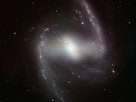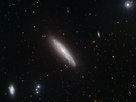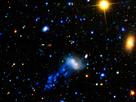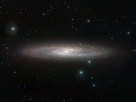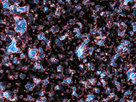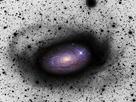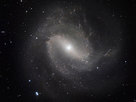HAWK-I
Spiral Galaxies Stripped Bare
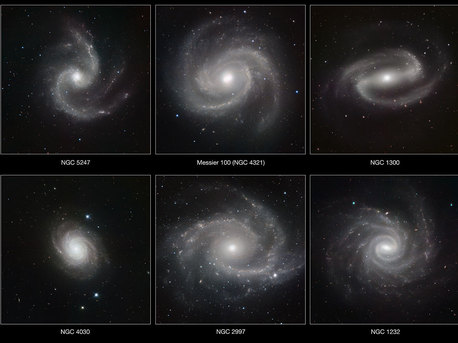 © ESO/P. Grosbøl
|
Six spectacular spiral galaxies are seen in a clear new light in pictures from ESO’s Very Large Telescope (VLT) at the Paranal Observatory in Chile. The pictures were taken in infrared light, using the impressive power of the HAWK-I camera to help astronomers understand how the remarkable spiral patterns in galaxies form and evolve. From left to right the galaxies are NGC 5247, Messier 100 (NGC 4321), NGC 1300, NGC 4030, NGC 2997 and NGC 1232.
The six galaxies are part of a study of spiral structure led by Preben Grosbøl at ESO. These data were acquired to help understand the complex and subtle ways in which the stars in these systems form into such perfect spiral patterns.
The first image shows NGC 5247, a spiral galaxy dominated by two huge arms, located 60–70 million light-years away. The galaxy lies face-on towards Earth, thus providing an excellent view of its pinwheel structure. It lies in the zodiacal constellation of Virgo (the Maiden).
The galaxy in the second image is Messier 100, also known as NGC 4321, which was discovered in the 18th century. It is a fine example of a “grand design” spiral galaxy — a class of galaxies with very prominent and well-defined spiral arms. About 55 million light-years from Earth, Messier 100 is part of the Virgo Cluster of galaxies and lies in the constellation of Coma Berenices (Berenice’s Hair, named after the ancient Egyptian queen Berenice II).
The third image is of NGC 1300, a spiral galaxy with arms extending from the ends of a spectacularly prominent central bar. It is considered a prototypical example of barred spiral galaxies and lies at a distance of about 65 million light-years, in the constellation of Eridanus (the River).
The spiral galaxy in the fourth image, NGC 4030, lies about 75 million light-years from Earth, in the constellation of Virgo. In 2007 Takao Doi, a Japanese astronaut who doubles as an amateur astronomer, spotted a supernova — a stellar explosion that is briefly almost as bright as its host galaxy — going off in this galaxy.
The fifth image, NGC 2997, is a spiral galaxy roughly 30 million light-years away in the constellation of Antlia (the Air Pump). NGC 2997 is the brightest member of a group of galaxies of the same name in the Local Supercluster of galaxies. Our own Local Group, of which the Milky Way is a member, is itself also part of the Local Supercluster.
Last but not least, NGC 1232 is a beautiful galaxy some 65 million light-years away in the constellation of Eridanus (the River). The galaxy is classified as an intermediate spiral galaxy — somewhere between a barred and an unbarred spiral galaxy. An image of this galaxy and its small companion galaxy NGC 1232A in visible light was one of the first produced by the VLT. HAWK-I has now returned to NGC 1232 to show a different view of it at near-infrared wavelengths.
As this galactic gallery makes clear, HAWK-I lets us see the spiral structures in these six bright galaxies in exquisite detail and with a clarity that is only made possible by observing in the infrared.
Notes
[1] HAWK-I stands for High-Acuity Wide-field K-band Imager. More technical details about the camera can be found in an earlier press release (eso0736).
[2] More information about the VLT instruments can be found at: http://www.eso.org/public/teles-instr/vlt/vlt-instr.html.
Source: ESO
HAWK-I
Spiral Galaxies Stripped Bare
 © ESO/P. Grosbøl
|
Six spectacular spiral galaxies are seen in a clear new light in pictures from ESO’s Very Large Telescope (VLT) at the Paranal Observatory in Chile. The pictures were taken in infrared light, using the impressive power of the HAWK-I camera to help astronomers understand how the remarkable spiral patterns in galaxies form and evolve. From left to right the galaxies are NGC 5247, Messier 100 (NGC 4321), NGC 1300, NGC 4030, NGC 2997 and NGC 1232.
The six galaxies are part of a study of spiral structure led by Preben Grosbøl at ESO. These data were acquired to help understand the complex and subtle ways in which the stars in these systems form into such perfect spiral patterns.
The first image shows NGC 5247, a spiral galaxy dominated by two huge arms, located 60–70 million light-years away. The galaxy lies face-on towards Earth, thus providing an excellent view of its pinwheel structure. It lies in the zodiacal constellation of Virgo (the Maiden).
The galaxy in the second image is Messier 100, also known as NGC 4321, which was discovered in the 18th century. It is a fine example of a “grand design” spiral galaxy — a class of galaxies with very prominent and well-defined spiral arms. About 55 million light-years from Earth, Messier 100 is part of the Virgo Cluster of galaxies and lies in the constellation of Coma Berenices (Berenice’s Hair, named after the ancient Egyptian queen Berenice II).
The third image is of NGC 1300, a spiral galaxy with arms extending from the ends of a spectacularly prominent central bar. It is considered a prototypical example of barred spiral galaxies and lies at a distance of about 65 million light-years, in the constellation of Eridanus (the River).
The spiral galaxy in the fourth image, NGC 4030, lies about 75 million light-years from Earth, in the constellation of Virgo. In 2007 Takao Doi, a Japanese astronaut who doubles as an amateur astronomer, spotted a supernova — a stellar explosion that is briefly almost as bright as its host galaxy — going off in this galaxy.
The fifth image, NGC 2997, is a spiral galaxy roughly 30 million light-years away in the constellation of Antlia (the Air Pump). NGC 2997 is the brightest member of a group of galaxies of the same name in the Local Supercluster of galaxies. Our own Local Group, of which the Milky Way is a member, is itself also part of the Local Supercluster.
Last but not least, NGC 1232 is a beautiful galaxy some 65 million light-years away in the constellation of Eridanus (the River). The galaxy is classified as an intermediate spiral galaxy — somewhere between a barred and an unbarred spiral galaxy. An image of this galaxy and its small companion galaxy NGC 1232A in visible light was one of the first produced by the VLT. HAWK-I has now returned to NGC 1232 to show a different view of it at near-infrared wavelengths.
As this galactic gallery makes clear, HAWK-I lets us see the spiral structures in these six bright galaxies in exquisite detail and with a clarity that is only made possible by observing in the infrared.
Notes
[1] HAWK-I stands for High-Acuity Wide-field K-band Imager. More technical details about the camera can be found in an earlier press release (eso0736).
[2] More information about the VLT instruments can be found at: http://www.eso.org/public/teles-instr/vlt/vlt-instr.html.
Source: ESO






